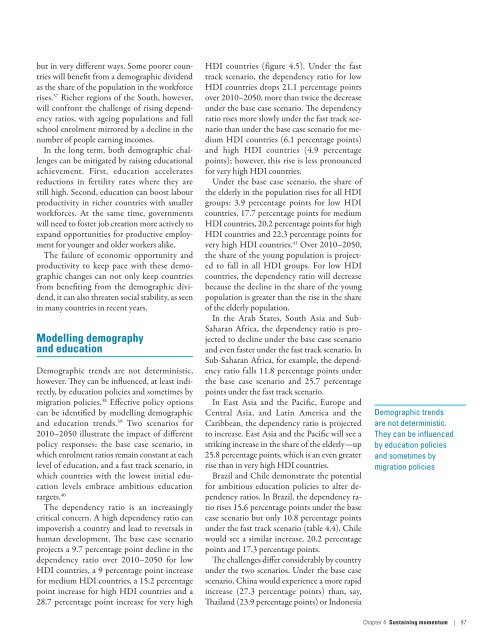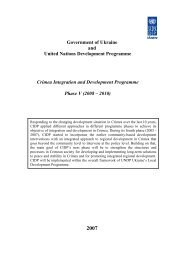E N S W - United Nations Development Programme
E N S W - United Nations Development Programme
E N S W - United Nations Development Programme
Create successful ePaper yourself
Turn your PDF publications into a flip-book with our unique Google optimized e-Paper software.
ut in very different ways. Some poorer countries<br />
will benefit from a demographic dividend<br />
as the share of the population in the workforce<br />
rises. 37 Richer regions of the South, however,<br />
will confront the challenge of rising dependency<br />
ratios, with ageing populations and full<br />
school enrolment mirrored by a decline in the<br />
number of people earning incomes.<br />
In the long term, both demographic challenges<br />
can be mitigated by raising educational<br />
achievement. First, education accelerates<br />
reductions in fertility rates where they are<br />
still high. Second, education can boost labour<br />
productivity in richer countries with smaller<br />
workforces. At the same time, governments<br />
will need to foster job creation more actively to<br />
expand opportunities for productive employment<br />
for younger and older workers alike.<br />
The failure of economic opportunity and<br />
productivity to keep pace with these demographic<br />
changes can not only keep countries<br />
from benefiting from the demographic dividend,<br />
it can also threaten social stability, as seen<br />
in many countries in recent years.<br />
Modelling demography<br />
and education<br />
Demographic trends are not deterministic,<br />
however. They can be influenced, at least indirectly,<br />
by education policies and sometimes by<br />
migration policies. 38 Effective policy options<br />
can be identified by modelling demographic<br />
and education trends. 39 Two scenarios for<br />
2010–2050 illustrate the impact of different<br />
policy responses: the base case scenario, in<br />
which enrolment ratios remain constant at each<br />
level of education, and a fast track scenario, in<br />
which countries with the lowest initial education<br />
levels embrace ambitious education<br />
targets. 40<br />
The dependency ratio is an increasingly<br />
critical concern. A high dependency ratio can<br />
impoverish a country and lead to reversals in<br />
human development. The base case scenario<br />
projects a 9.7 percentage point decline in the<br />
dependency ratio over 2010–2050 for low<br />
HDI countries, a 9 percentage point increase<br />
for medium HDI countries, a 15.2 percentage<br />
point increase for high HDI countries and a<br />
28.7 percentage point increase for very high<br />
HDI countries (figure 4.5). Under the fast<br />
track scenario, the dependency ratio for low<br />
HDI countries drops 21.1 percentage points<br />
over 2010–2050, more than twice the decrease<br />
under the base case scenario. The dependency<br />
ratio rises more slowly under the fast track scenario<br />
than under the base case scenario for medium<br />
HDI countries (6.1 percentage points)<br />
and high HDI countries (4.9 percentage<br />
points); however, this rise is less pronounced<br />
for very high HDI countries.<br />
Under the base case scenario, the share of<br />
the elderly in the population rises for all HDI<br />
groups: 3.9 percentage points for low HDI<br />
countries, 17.7 percentage points for medium<br />
HDI countries, 20.2 percentage points for high<br />
HDI countries and 22.3 percentage points for<br />
very high HDI countries. 41 Over 2010–2050,<br />
the share of the young population is projected<br />
to fall in all HDI groups. For low HDI<br />
countries, the dependency ratio will decrease<br />
because the decline in the share of the young<br />
population is greater than the rise in the share<br />
of the elderly population.<br />
In the Arab States, South Asia and Sub-<br />
Saharan Africa, the dependency ratio is projected<br />
to decline under the base case scenario<br />
and even faster under the fast track scenario. In<br />
Sub-Saharan Africa, for example, the dependency<br />
ratio falls 11.8 percentage points under<br />
the base case scenario and 25.7 percentage<br />
points under the fast track scenario.<br />
In East Asia and the Pacific, Europe and<br />
Central Asia, and Latin America and the<br />
Caribbean, the dependency ratio is projected<br />
to increase. East Asia and the Pacific will see a<br />
striking increase in the share of the elderly—up<br />
25.8 percentage points, which is an even greater<br />
rise than in very high HDI countries.<br />
Brazil and Chile demonstrate the potential<br />
for ambitious education policies to alter dependency<br />
ratios. In Brazil, the dependency ratio<br />
rises 15.6 percentage points under the base<br />
case scenario but only 10.8 percentage points<br />
under the fast track scenario (table 4.4). Chile<br />
would see a similar increase, 20.2 percentage<br />
points and 17.3 percentage points.<br />
The challenges differ considerably by country<br />
under the two scenarios. Under the base case<br />
scenario, China would experience a more rapid<br />
increase (27.3 percentage points) than, say,<br />
Thailand (23.9 percentage points) or Indonesia<br />
Demographic trends<br />
are not deterministic.<br />
They can be influenced<br />
by education policies<br />
and sometimes by<br />
migration policies<br />
Chapter 4 Sustaining momentum | 97
















